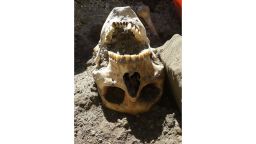It was a fascinating discovery. Archaeologists in Pompeii, Italy, unearthed the skeletal remains of a man thought to have survived the eruption of Mt. Vesuvius in A.D. 79 – only to be killed by a flying stone block as he fled.
The findings, announced in May, were based on the position of a huge stone block next to the lower part of the man’s skeleton. Archaeologists said they believed the block severed the man’s body and crushed the upper part, believed to be under the stone.
But further research at the site has yielded the missing upper limbs, thorax and skull, researchers said this week, leading them to conclude the unlucky man died not from a projectile but from asphyxiation caused by the pyroclastic flow. That’s the blazing-hot mixture of gas, lava fragments and other debris belched out by a volcano.

Pictures from the excavation showed the large block – possibly a doorjamb – protruding from the ground just above the lower part of the skeleton, as though the man had been pinned by the flying stone.
Archaeologists now say a tunnel discovered below the body, dating from the Bourbon era of the 1700s and 1800s, caved in and caused the upper part of the skeleton to fall away.
“The identified skeletal remains consist of the upper part of the thorax, the upper limbs, the skull and jaw,” read a news release from the Pompeii Archaeological Park. “Currently undergoing analysis, they display some fractures, the nature of which will be identified, so as to be able to reconstruct the final moments in the life of the man with greater accuracy.”
Since the discovery of the man’s body, archaeologists have also discovered the remains of a small purse that the man “clutched close to his chest” containing 20 silver and two bronze coins.
While experts are still examining the coins, archaeologists say they appear to have had enough value to maintain a family of three for two weeks.
Researchers say the man was at least 30 years old. Lesions on the skeleton’s tibia are signs of a bone infection that probably caused him to limp and hampered any attempt at escape.
CNN’s Gianluca Mezzofiore and Valentina DiDonato contributed to this report.



![An expert works to uncover one of the 20 wooden sculptures which were recently discovered at the ancient archaeological site of Chan Chan, in the outskirts of the northern city of Trujillo, in Peru, on October 22, 2018, - The unique sculptures found in niches are fixed to the ground measuring an average of 70 centimeters and representing different characters. (Photo by CRIS BOURONCLE / AFP) / The erroneous mention[s] appearing in the metadata of this photo by CRIS BOURONCLE has been modified in AFP systems in the following manner: [20] instead of [19]. Please immediately remove the erroneous mention[s] from all your online services and delete it (them) from your servers. If you have been authorized by AFP to distribute it (them) to third parties, please ensure that the same actions are carried out by them. Failure to promptly comply with these instructions will entail liability on your part for any continued or post notification usage. Therefore we thank you very much for all your attention and prompt action. We are sorry for the inconvenience this notification may cause and remain at your disposal for any further information you may require. (Photo credit should read CRIS BOURONCLE/AFP/Getty Images)](https://media.cnn.com/api/v1/images/stellar/prod/181023153544-chan-chan-statues-1.jpg?q=x_5,y_251,h_2767,w_4917,c_crop/w_250)















